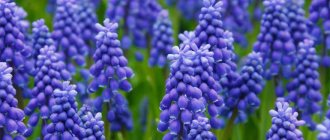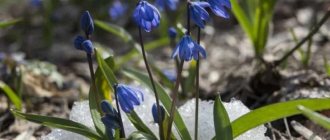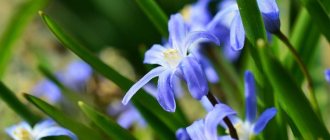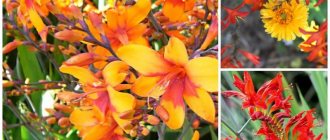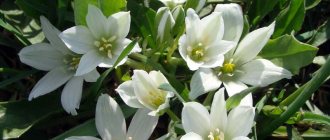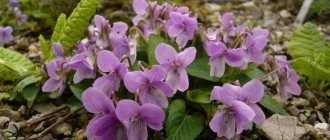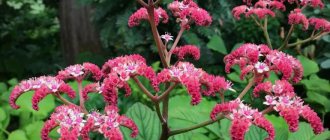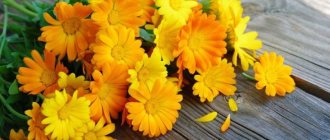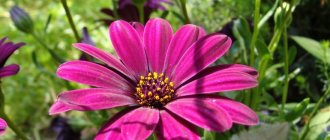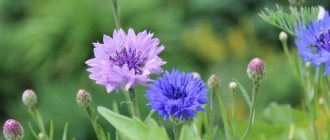Muscari flowers are compact miniature plants that can please the eye in early spring, when other crops are still dormant or have just begun to awaken after winter. The flower looks especially impressive in large group plantings, creating the impression of a bright spot. Muscari is also suitable for forcing if favorable conditions are created.
Mouse hyacinth is an excellent honey plant
Description of muscari flowers
The culture belongs to the Hyacinth family. Under natural conditions it grows in the Caucasus, Southern Europe, the Mediterranean, Crimea, as well as Central and Asia Minor, preferring to grow in mountainous areas. The flower received its name for its pleasant smell, which resembles musk. But it is also called viper onion.
Every spring, the mouse hyacinth initially develops a basal rosette of straight leaves, which consists of 7-9 pieces. Its plates reach 18 cm, their surface is matte, without a pattern.
Important! In some flower varieties, leaves can grow back in the fall and remain green over the winter.
What does a muscari bulb look like?
The underground part of mouse hyacinth is represented by a round, ovoid bulb. Its length reaches 2.5-3 cm, and its diameter does not exceed 2 cm. On top it is covered with light-colored scales. During the period of active growth, a bunch of roots appears from the bottom.
Important! Mouse hyacinth is a short-growing crop, since after a short period of growth, its bulb enters a dormant period.
When do muscari bloom?
The flowering period of muscari depends on weather conditions and the characteristics of the variety. This can happen at the end of March and until June. The flowering period of mouse hyacinth is three to four weeks. At this time, a fleshy peduncle appears from the center of the leaf rosette, the height of which reaches 10-15 cm. It has a racemose shape, many small flowers are formed on it, tightly pressed to each other. In their shape, the buds of mouse hyacinth resemble a lily of the valley, since they have petals fused at the base. In the photo you can see a close-up of muscari flowers, where you can clearly see how their edges are strongly bent and divided into six lobes.
When the buds open, an intense pleasant smell is felt, which intensifies in the evening and after rain. The color of muscari flowers, according to the description of the plant, can be white, purple, blue, indigo, and in rare cases yellow. Sometimes there is a contrasting border along the edge.
After pollination of flowers, mouse hyacinth produces fruit-boxes with fleshy walls of a heart-shaped or spherical shape. Inside them are small dark brown seeds.
The inflorescence of mouse hyacinth blooms from bottom to top
Is muscari poisonous or not?
The perennial belongs to the category of poisonous crops. Therefore, all work with this flower should be carried out with gloves. In people with hypersensitivity, contact with the bulbs and its aerial parts can cause skin dermatitis.
Muscari is a perennial or annual plant
Mouse hyacinth is a perennial crop. The lifespan of one bulb is five to six years. After this, she dies, leaving offspring.
Care
This representative of the flora does not require mandatory pruning. But if the flower grows in decorative flower beds, then yellow leaves and drooping flowers are periodically removed from it.
Landing
Most subspecies are unpretentious plants. Mouse Hyacinth has excellent rooting and seed growth. When planting, you must take into account that the flower loves sunny areas .
Planting is done in small groups of 15-25 pieces. If the planting material was purchased, then the bulbs are pre-moistened with a growth stimulation solution. A purchased Fitosporin solution is suitable for this.
The distance between the bushes should be at least 5-8 cm. Planting depth - up to 7 cm. It is also necessary to take into account the size of the bulbs. The larger the bulb, the more space needs to be left for the future plant. There should be a small layer of 1.5 cm of black soil above the bulb. Plants should not be buried too deeply. Otherwise, the planting will not sprout and will rot in the soil.
For 1 sq. It is recommended to plant 100-200 flowers . If planting is done on a decorative lawn, then the turf 6-7 cm deep must be removed from the area. After this, the soil is well loosened and complex fertilizers in the form of compost are added. Next, planting material is planted. After a successful procedure, the cut lawn is returned to its original place. Do not press down the soil too much.
Important!
During the growing season, it is recommended to feed the perennial once every 20-25 days . Complex store-bought fertilizers for indoor flowers are suitable for this. In autumn or winter, the plant does not need feeding.
Types and varieties of muscari
There are about sixty species of mouse hyacinth found in nature. Also, thanks to selection, it was possible to obtain new modern hybrid forms of this bulbous crop. Therefore, you should familiarize yourself with the photos and names of the most popular varieties of muscari.
Important! Several flower stalks may appear from one bulb.
Muscari Armenian
This species is called Colchian. The flower grows in the conditions of Transcaucasia and Turkey. Armenian mouse hyacinth (Muscari armeniacum) is characterized by a multi-flowered, almost spherical inflorescence. Its basal rosette consists of 3-7 plates. The species overwinters without leaves. Blooms in late spring.
The Armenian species has upper buds of a lighter shade
Muscari Armenian Fantasy Creation
Muscari terry Fantasy Creation is characterized by a greenish tint of the petals, which later becomes deep blue. The height of the flower reaches 20 cm. The basal rosette consists of five to seven leaves. The flowering period begins in mid-May.
Fantasy Creation does not require shelter for the winter
Muscari Pink Sunrise
This variety has flowers of a soft pink hue. Muscari Pink Sunrise does not exceed 15 cm in height. The shape of the inflorescences is pyramidal. They appear at the end of May.
Pink Sunrise is suitable for border plantings
Pink Surprise
This variety has soft pink flowers. Muscari Pink Surprise has a height of no more than 20 cm. The flowering period begins at the end of April and lasts three weeks.
The diameter of Pink Surprise flowers is 2 cm
Peppermint
The height of the Peppermint muscari flower is about 20 cm. The variety blooms in the second half of May. The basal rosette of leaves consists of 5-7 pieces. The shade of the petals is pale blue. The leaves are dark green in color.
Peppermint gives off a pleasant scent when the flowers open.
Muscari grapevine
The flowers of this species are collected in racemose inflorescences. The number of leaves in a rosette is 2-6 pieces. The height of the bare peduncle of the mouse hyacinth (Muscari botryoides) reaches 12 cm. The petals are blue with a slight purple tint and a white contrasting edge.
Flowers of the cluster-shaped species bloom in early May
Muscari grapevine Album
A special feature of the variety is the white tint of the petals with a beige tint. Flowers bloom at the end of April. Album's rosette of leaves consists of 3-5 pieces. Flower height 15 cm.
The album looks good in group plantings
Muscari latifolia
The culture is thermophilic. Mouse hyacinth (Muscari latifolium) has a full peduncle, consisting of one hundred buds. The shade of the petals is dark purple. Muscari latifolium (photo below) blooms in April. Two or three flower stalks emerge from one bulb.
Broadleaf viper onion has cylindrical peduncles 6 cm long
Important! Mouse hyacinth broadleaf can freeze slightly in snowless winters, so it requires shelter.
Muscari crested
During the flowering period, the height of a plant of this species can reach 70 cm. The basal rosette consists of belt-shaped leaves. The inflorescence is loose, racemose, containing 40-100 buds. The color of the petals of the crested mouse hyacinth (Muscari comosum) is light brown with a cream edge. The bulb has the shape of a wide cone.
Mouse crested hyacinth produces many leaves and flowers in nutritious soil
Plumosum
This variety of mouse hyacinth is distinguished by a lilac-violet hue of the petals. The flowers are thread-like, which makes it stand out from other types of crops; the height is 20 cm. The basal rosette consists of 5-7 leaves of a rich green color. Muscari Plumosum is demanding in terms of planting and care. Flowers bloom in mid-May.
Important! Plumosum is unstable in the middle zone and freezes out in snowless winters.
Plumosum forms two or three peduncles from one bulb
Muscari pale
This species is one of the rarest and smallest. Pale mouse hyacinth (Muscari pallens) has an ovoid bulb, the length of which is 1.5-3 cm. The leaf rosette consists of 2-6 pieces, the length of the plates is about 18-20 cm. The inflorescences consist of 30-40 buds. The color of the petals is pale blue with white teeth along the edge. Flowering occurs at the end of May.
The throat of flowers in the pale species is not constricted, like in others
White Beauty
This variety of mouse hyacinth is distinguished by a pale pink shade of petals, and they are lighter in the upper part of the inflorescence and darker at the bottom. The height of this species reaches 25 cm. The basal rosette of the White Beauty flower consists of three or four plates of a rich green hue.
The length of the inflorescences of the mouse hyacinth variety White Beauty is 5 cm
Muscari ambrosia
In some sources, this type of culture can be found under the name Muscarimia mouse. Ambrosia hyacinth (Muscari ambrosiacum) is characterized by racemose inflorescences, which consist of 20-50 buds. The color of the petals of this species changes as the buds open. Blooms in mid-April. Initially the color is purple, and then lightens, becomes greenish and finally acquires a creamy tint.
The ragweed species has sterile flowers with a purple tint.
Muscari neglected
A rare species of mouse hyacinth, which is listed in the Red Book. The height of the flower reaches 20 cm. The leaves of the neglected mouse hyacinth (Muscari neglectum) are belt-shaped, dark green in color. The length of the peduncles does not exceed 5 cm; they consist of 20-30 buds.
Neglected mouse hyacinth is found mainly in forest-steppe and steppe zones
Muscari azure
In some sources, this species is found as azure or muscari Azureum. The plant reaches a height of 15-20 cm. And the inflorescence size is about 8 cm. Each of them contains 30-60 buds. The rules for planting and caring for the azure muscari flower are the same as for other species. The petals at the top of the inflorescence are lighter than at the bottom.
The azure species blooms in late April - early May
Muscari Oshe
This species has bulbs no more than 1.7-2 cm. The basal rosette of leaves in the Oshe mouse hyacinth (Muscari aucheri) consists of two or three leaves. The bare peduncle reaches a height of 10-15 cm. This type of muscari (photo below) has blue buds with pale teeth along the edge. The perianth is oblong.
Important! Oshe does not tolerate prolonged stagnation of moisture in the soil.
Oshe mouse hyacinth overwinters without leaves
Blue Magic
A modern variety that is highly decorative. At the top of the sky-blue inflorescences there is a white tuft that attracts the eye. Blue Magic blooms buds at the end of April, this period lasts about four weeks. The height of the bushes reaches 20 cm.
Blue Magic easily adapts to any climatic conditions
Muscari large-fruited
The large-fruited mouse hyacinth flower (Muscari macrocarpum) is a heat-loving crop, so in temperate climates it can only be grown in containers. The buds are yellow, fragrant.
Important! The bulb of this type of crop dies at temperatures below +5 degrees.
The flowers of the large-fruited species open in May
Golden Fragrance
This variety of muscari is characterized by a purple hue of buds, which subsequently acquires a bright yellow color. The height of the bushes of Golden Fragrance muscari reaches 30 cm. The leaves are up to 20 cm long, their width is 2 cm.
Mouse hyacinth Golden Fragrance is suitable for forcing
Muscari vulgare
A low-growing species, the height of the bushes barely reaches 12 cm. In nature, the common mouse hyacinth (Muscari botryoides) can be found in the Caucasus, as well as in Southern and Western Europe. The leaves of the plant are erect, linear, dark green in color.
Important! Common mouse hyacinth is considered the most fragrant type of crop.
The color of the petals in the common species is blue, light blue, or less often white.
Muscari Liriope
A special feature of this variety is the rhizomatous underground part. In most cases, gardeners plant and care for Muscari Liriope at home, growing it in pots. The leaves are xiphoid, hard, dark green with longitudinal light stripes. Flowers bloom in autumn. The color of the petals is purple or white.
The height of Liriope bushes reaches 60 cm
Muscari is nice
A wild species of mouse hyacinth that is not used in gardening. Pretty Muscari (Muscari pulchellum) has small bushes, the height of which does not exceed 12 cm. Pretty Muscari (photo below) has blue flowers. The diameter of the buds when opened does not exceed 0.7 cm.
The perianth of a pretty species is spherical in shape, slightly narrowed at the throat
Benefits and harms
Small blue bells are used to decorate the area. They create a charming atmosphere, giving the site aesthetic beauty. Muscari goes well with other plants:
- tulips;
- lilies of the valley;
- woodlands;
- hazel grouse;
- forget-me-nots
Mouse flower is a poisonous plant and is not used in official medicine. Basically, alcohol tinctures are made from it for external use. In Asian countries it is used as a wound healing agent. Essential oils are obtained from the bulb, which are used to treat colds, bronchitis, and insomnia.
Tinctures and oils are contraindicated for pregnant women, children and people with individual intolerance. People with sensitive skin should wear gloves when handling the plant.
Diseases and pests
Mouse hyacinth is resistant to many diseases. More often, the plant suffers from mosaic; the disease is caused by the yellow dwarf onion virus. Main symptoms:
- short florist;
- the leaves have a green pattern resembling a mosaic;
- cessation of plant growth.
The infection is mainly transmitted by aphids; when the virus gets on the bulb, it begins to multiply. There is currently no cure for this disease. The only way to cope with the disease is to remove the infected plants and burn them. If an aphid is discovered that is a carrier of the virus, it must be destroyed immediately. A special solution is used for this. Dilute two teaspoons of liquid soap in two glasses of water and spray the plant with the liquid.
The flower can be attacked by spider mites. You can cope with it using the avermectin group. Before use, carefully study the description, spray the product at a temperature of 17 degrees Celsius.
How do muscari reproduce?
To obtain new flower seedlings, you can use seeds and dividing the bulb. The first method is very labor-intensive and time-consuming, so flower growers rarely resort to it. Muscari seeds remain fresh for only 1 year, so sowing should not be delayed.
Planting should be carried out immediately after harvesting in the fall in open ground to a depth of 1-2 cm. During the winter, natural stratification of the seeds occurs, and seedlings appear in early spring. The bulbs form within five months. They bloom in the third year after planting.
Important! When grown from seeds, the species properties of mouse hyacinth are not preserved.
The easiest way to propagate a flower is to separate the daughter bulbs. This should be done every three to four years. It should be planted in August - September at a distance of 10-15 cm and a depth of 4-6 cm.
Diseases and pests
The plant is unpretentious to grow. Therefore, there are no diseases with improper care. Not susceptible to pests. But excessive watering should be avoided when planting. Otherwise, the root system may rot.
Want to know about other types of hyacinth? Then be sure to read our article about Water hyacinth, which is also called Eichornia.
Mouse Hyacinth is an excellent cultivated plant. Does not require special care. Recommended for amateur flower growers. Loves loose, breathable soil, fertilizing and systematic watering.
When to plant muscari bulbs in open ground
Muscari can be planted in a permanent place in autumn and spring, depending on the region. Each of these methods has certain features that need to be taken into account.
When to plant muscari in the fall
This planting date is preferable, as it allows the plant to bloom next spring. It is recommended to carry out the procedure at the end of August or September, depending on the conditions of the growing region.
Planting muscari in spring
During this period of the year, it is recommended to transplant muscari to another place of heavily overgrown bushes. To do this, you need to dig up the mother flower, divide it into daughter bulbs and immediately plant it in a permanent place.
When planted in spring, viper onions bloom only after a year
Botanical description and photo of mouse hyacinth
Muscari is native to North Africa, Central Asia and the Mediterranean. The flower was brought to Australia and North America, where it took root well. Mouse hyacinth is an ornamental plant with an erect stem and a dense multi-flowered inflorescence in the shape of a brush. Small ovoid bulbs have a diameter of 2-2.5 cm. The perianth is fused with six petals. The jagged edges are bent outward. Leaves are basal, narrow, linear in shape. Length 10-17 cm, green color.
Mouse hyacinth
Flowering, depending on the species, begins in April-May and lasts 20-25 days. The main colors of the flowers are blue, light blue and violet. Of the 44 species found in nature, breeders have created hundreds of varieties that differ in the range of shades and flower shapes. Reproduction occurs by bulbs and seeds. At the end of flowering, a box is formed filled with small black seeds. Self-seeding often occurs. After seed propagation, 2-3 years pass before flowering begins.
Interesting fact. The upper flowers of the raceme are usually sterile. They may differ in shape or color.
The flower received its Latin name Muscari from Philip Miller, an English botanist, who detected notes of musk in their aroma. Mouse hyacinth is a synonymous name that has taken root in Europe. Its reason is obvious - its small size and striking resemblance to hyacinths. Some varieties are called grape hyacinths, they really look like a bunch of berries.
The ornamental plant spends most of its life in a dormant state. The growing season begins in spring and continues until early summer. In a short period of time, the viper onion should have time to bloom and accumulate nutrients in the bulb. In addition to decorative use, the plant is used in cosmetology and perfumery. Essential oil and alcohol extracts are made from its fragrant petals. The products have a rejuvenating and antiseptic effect.
Information. Mouse hyacinths grow quickly, and many children are formed around the mother bulb over the course of a season.
Planting and caring for muscari in open ground
This culture is one of the undemanding ones. Therefore, growing and caring for muscari in open ground will not be difficult even for a novice gardener. It is enough just to adhere to the standard rules of agricultural technology, taking into account the requirements of this plant.
Growing conditions
For this bulbous perennial, it is necessary to choose sunny, open areas that prevent stagnation of moisture. You can also plant viper onions under the canopy of trees and tall shrubs, with good plant lighting.
This culture prefers to grow on loamy or sandy loam soil with low acidity. It is important that the soil allows moisture and air to pass through well. Before planting, you must first add humus at the rate of 5 kg per square meter. m.
How to plant muscara
Before planting the bulbs, you need to disinfect them in a solution of the “Maxim” preparation. Also, the soil in the area where this crop will grow should be watered in advance with this fungicide.
You need to plant at a distance of 10-15 cm. Large bulbs should be buried 7 cm, and small ones - 3 cm. Small tubers should be planted very close, 10-25 pieces each. And after a year or two, plant them.
Procedure:
- Make a hole.
- Water it and wait for the moisture to be absorbed.
- Pour sand 1-2 cm thick onto the bottom.
- Place an onion on it.
- Sprinkle with soil, compact and level the surface.
You can make the process of digging up bulbs easier in the future by planting them in baskets
Aftercare
Watering the plant is necessary only during a long absence of rain. Viper onions need to be fertilized twice per season. The first time fertilizing should be done in the spring with organic matter, at the very beginning of the growing season, and the second time after flowering, using phosphorus-potassium mineral mixtures.
Caring for this crop involves loosening the soil and timely removal of weeds. After the flower stalks wither, they need to be cut off, but the leaves should be left. It is thanks to the plates that the bulb accumulates nutrients for successful wintering and flowering in the next season.
The above-ground part of the plant should only be cut off in late autumn. There is no need to insulate flowers for the winter.
Important! Heat-loving varieties should be dug up and stored in a cool, dry place until spring.
Muscari bushes need to be replanted every three to four years.
When and how to plant and replant muscari
It is necessary to separate the daughter bulbs every three to four years. This procedure can be done in the spring before the growing season begins or in the fall after it ends. To do this, you need to dig up the bush and clear it of soil. Then carefully separate the daughter bulbs. Before planting, they should be pre-soaked in a fungicide solution for disinfection. After this, immediately plant it in a new place.
Features of growing a plant
When growing a Mediterranean guest, it is important to provide it with a large area. The curtain spreads quite quickly. Flowerbed neighbors are selected taking into account the fact that you will only be replanting in a few years; it is better to plant together with other perennials.
Among the unique properties of the viper onion, it is worth noting its love of light, but the ability to grow in the shade. This feature is associated with the early flowering period. The bright heads will appear before the leaves emerge on trees shading the garden.
Ephemeroids are planted in small groups. A single flower will not give the desired effect. Like other representatives of bulbous crops, mouse hyacinth is used for early forcing. Even when there is snow outside the window, the house can be filled with the honey aroma of a flower.
Planting and caring for muscari at home
Viper onions, like tulips, can be forced at home. Therefore, if you wish, you can grow a spring bouquet by a certain date. But for this venture to be successful, you must adhere to certain rules.
Distilling muscari at home
In order for muscari to bloom in a pot at home, you need to select large bulbs measuring at least 2.5-3 cm. They should first be dug up, cleared of soil and dried well. In October, it is necessary to prepare containers with a height of no more than 10 cm. They need to be filled with a nutrient substrate consisting of turf, peat, sand and humus in a ratio of 2:1:1:1.
Planting should be done in moist soil to a depth of 3 cm so that the bulbs do not touch each other. At the end of the procedure, they need to be watered.
In the future, a cooling period is required. Therefore, initially containers with planted bulbs should be kept for 1 month at a temperature of +9 degrees, and then kept at +5 °C for 60 days. Two weeks before the required date, mouse hyacinths should be placed on the windowsill.
How to care for muscari at home
Caring for plants in the house involves watering them in a timely manner as the earthen clod dries out. Also, during the period of leaf growth, you should feed the viper onion with calcium nitrate at the rate of 30 g per 10 liters of water.
After wilting, mouse hyacinth flower stalks should be cut off and the plants should continue to be watered as long as the leaves remain green. In the future, the bulbs will need to be removed from the ground, dried and planted in open ground in the fall.
Mouse hyacinth can be used again for forcing only after three years.
Important! To prolong the flowering of viper onions in the house, you need to keep the plant at a temperature no higher than +15 degrees.
How to grow in a container
The bulbs are planted in a plastic pot in the fall. If you plant not in a container, but directly in the soil, then when removed from the ground, you can destroy the plants by damaging their delicate roots. Be sure to first make holes in the pot for drainage, then drop it in the area.
In the spring, mouse hyacinths are transferred with a lump of earth from a pot into a cache-pot (its difference from a pot is that it has no drainage holes, and it can also be hung, as a result the plants in the apartment look very decorative).
When viper onions bloom in flowerpots, they are watered and fertilized more often than muscari growing in the garden. After the plants have flowered, they are again transplanted into a pot and buried in the ground, leaving them for the winter.
Muscari in landscape design
Muscari look good in a flower bed, as can be seen in the photo, and are also ideal for creating rock gardens and borders. Flowers need to be planted in whole groups, which accentuates attention.
Muscari goes well with tulips, hazel grouse, daffodils and other early flowering spring crops.
Muscari gets along with many garden crops
Will the hyacinth bloom?
Those who prefer to throw away bulbs that have been forced are partly right. We are often sold Dutch selection hyacinths in pots; they are characterized by poor winter hardiness. And if there is no flowering the next year, the bulb is probably dead.
But don't rush to get upset. Numerous experiences of amateur flower growers (just like you and me) have been able to achieve flowering of forced bulbs! It’s just that very often (and most likely) it’s not the time yet. Forcing is a lot of stress for the plant. Usually the next year the plant rests, gains strength, and blooms only two years after forcing (that is, in the spring).
